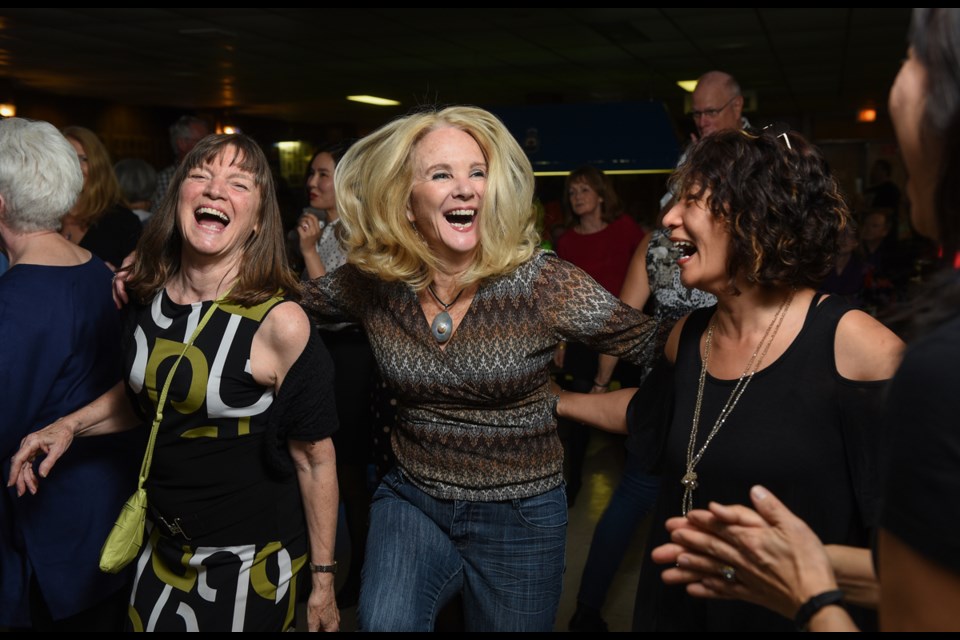The walls in Branch 142 of the West Point Grey Royal Canadian Legion are charmingly outdated with wood paneling, the ceiling hangs low with office tiles and fluorescent lights and the floor is equipped with pool and shuffle board tables. All those archaic features add up to one great neighbourhood rec room.
“You won’t see many under 40 tonight,” noted Gord Walkinshaw as the crowd, many he knew on a first-name basis, lined up at the front door to pay the $5 cover Friday night. Walkinshaw plays keys for the Lord Byng Reunion Band, which is made up of five Class of ’65 graduates and one young ‘un, Gord’s brother Dave Walkinshaw, who graduated in 1973. “Just see how many people pull their cellphones out, there will be hardly any.”
Walkinshaw knows his audience. While his six-piece crammed into the cave of the stage, which, inexplicably, had an unlit neon “open” sign on the wall above, the worn vinyl seats filled. Old friends chattered and new introductions were made with cheap beers in hand instead of smartphones. Fellow graduates from the Lord Byng class of ’65 sat at the back of the room, acquainted with the band last June when they performed their first show at the school’s 50th reunion. Jeanine Ziolkoski and Peter Henley, who know Walkinshaw from the Kitsilano Yacht Club, sat near the pool table where players took short breaks from the game to play air guitar with their pool cues while the bands played. “We’ve been following Gord,” said Ziolokoski. “And wherever Gord goes, we follow!”
“Class of ’65,” singer Jim Mutter said into the mic before the Lord Byng Reunion Band kicked into a cover of “This Diamond Ring” by Gary Lewis and the Playboys. “It was a great year to graduate. Houses were cheap and we were lucky in love” — the crowd responded with whoops — “well, not all of us. As they say in the old Westerns, enough talking!”
Two golden oldies in, and the dance floor was packed. Mutter and his wife Mary Ann’s friends from their West Side zumba class were easy to spot by their energy that would put people half their age to shame. As Ziolkoski and Henley danced, their gaze went to their table where their two Labrador retrievers, puppies in training for the Pacific Assistance Dogs Society, slept underneath.
The Lord Byng Reunion Band ended the first set of their first show this year with, appropriately, the number one song of 1965, Sam the Sham and the Pharaohs’ “Wooly Bully.”
The collective stories in the building at the corner of West Broadway and Alma Streets are endless. The legion itself had humble beginnings in somebody’s West Side house before moving to its current location, which had to be rebuilt after a fire in 1971. Stories of its veterans, many of whose uniforms and other artifacts from wars are in the legion’s display cases, were published in a book about Branch 142 in 1992.
The musicians are a treasure of entertainment history, which is what happens when you’re 68 years old and you’ve been playing all your life. Walkinshaw’s career began after he was fired from Woodward’s department store in ’68. “Oh, I don’t know. Selling dope, probably. I had the long hair, bad attitude,” he laughed. “Sleeping on the job…”
Walkinshaw joined Vancouver’s circuit of unionized nightclub musicians and often worked the noon ‘til 8 p.m. shift six nights a week at the Zanzibar, New Delhi, Smilin’ Buddha and an assortment of other independent strip clubs in town. There was no shortage of work for musicians thanks to the B.C. Liquor Control Board’s 1973 ruling that exotic dancers had to be accompanied by a three-piece orchestra. (The ruling didn’t last long, though, and tape-recorded music put many nightclub musicians out of work.)
“Nobody wanted to be a rock star, we just wanted to play music,” Walkinshaw remembered. “We all knew each other, we subbed for each other, we’d just step up and play. There was no set list, no complicated P.A. system. You’d look around the room and see what mood everybody was in and what the dancers wanted to dance to, and that was your job.”
He plays for a different sort of dancer these days, women such as 69-year-old Marianne Schmidt who wears a pedometer on her hip to log in the steps she takes on the floor.
“Oh, I’ve known Gord since the 1970s. Gordie has a way of doing the songs that I love,” said Schmidt. “I just love to dance. I can’t stop. I do it at home, when I’m in a lineup… If I can’t really get into the music, then I don’t dance as wildly. I hear the music that I love so much then I can just let go. I don’t care what people think, or what they say.”
@rebeccablissett



